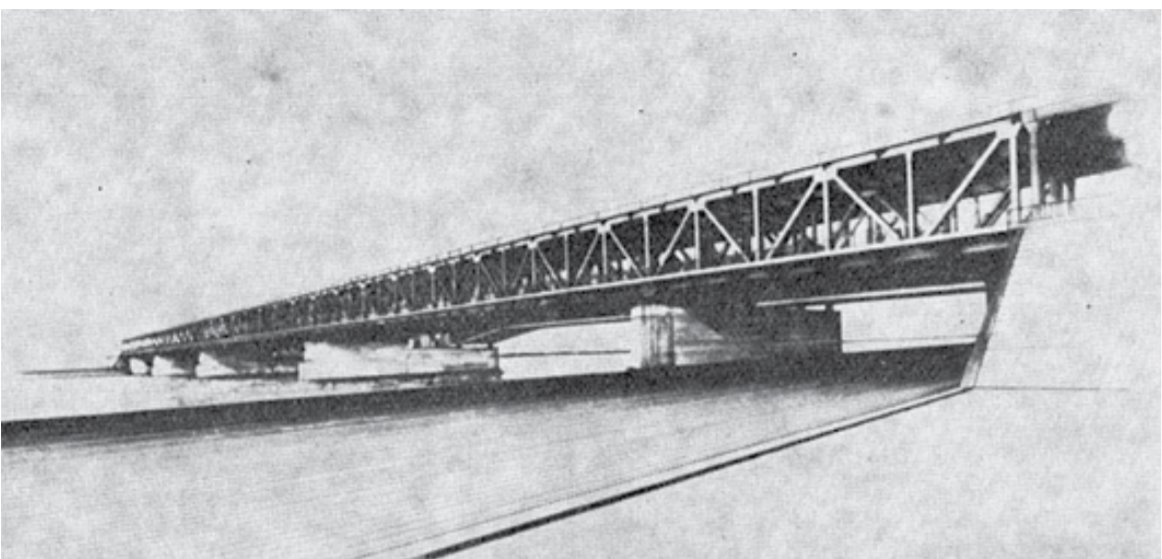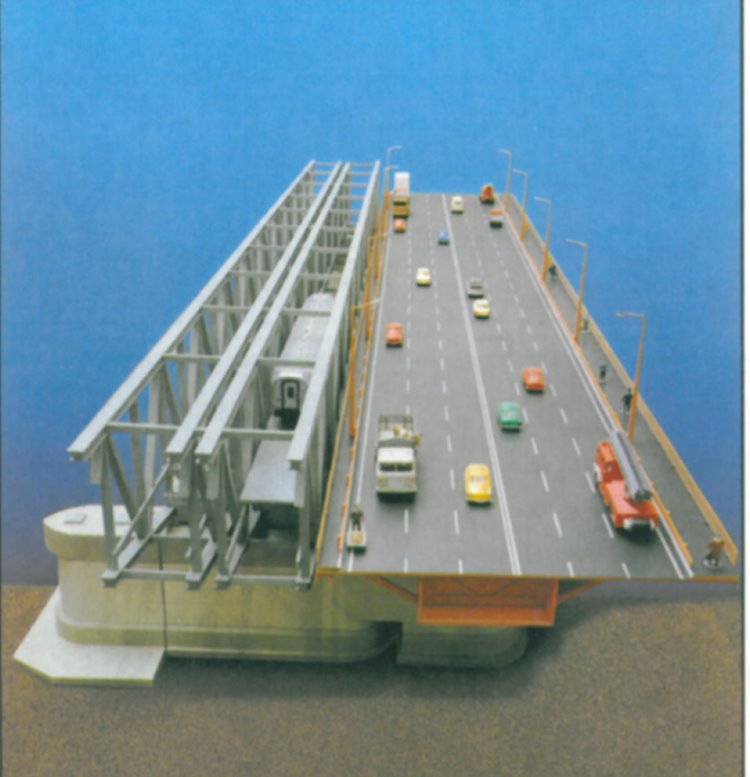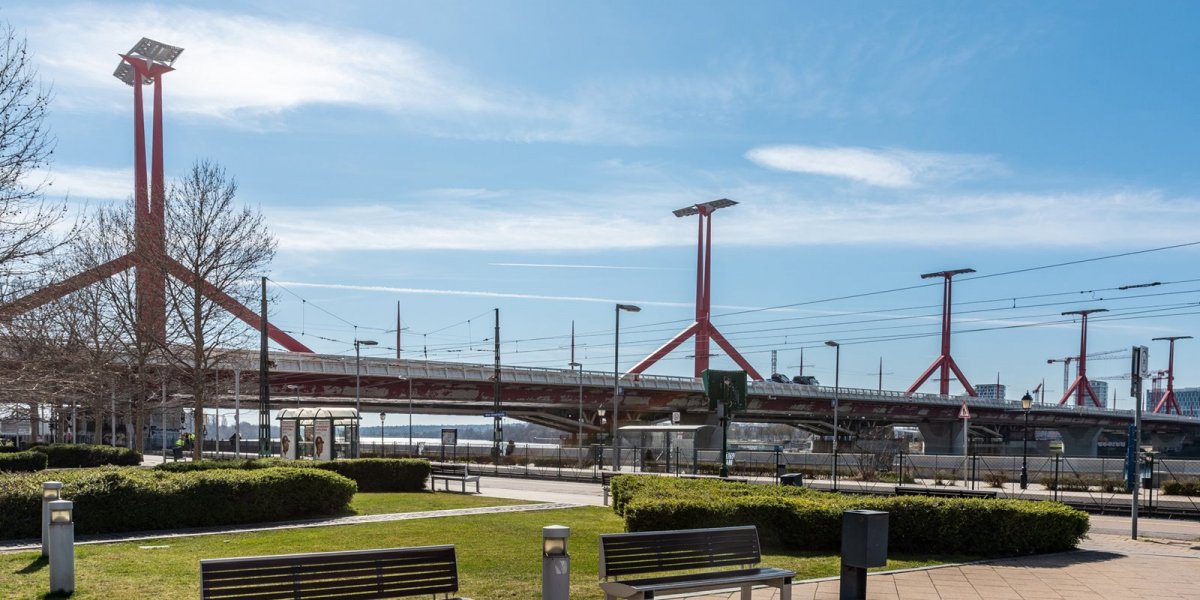On the site of today's Rákóczi Bridge (which was officially called the Lágymányosi Bridge until 2011, but many still call it that way), a new bridge was designed as early as the 1960s. True, at that time it was planned that the future national motorway network would be connected by a two-storey ring road on Hungária Boulevard.
That is why in the late 1960s, early 1970s, even a bridge connected to a highway was designed, and there was even a design tender. The winner was a huge concrete bridge, but in the end, they wanted to build not that, but a two-story, truss steel bridge. However, the concept of the Hungária Boulevard motorway was replaced by the M0 plan in the mid-1970s, so the bridge was abandoned at that time.

The two-story truss bridge, designed in the 1970s (Photo: Városi Közlekedés 1971/4)
Why did they count on the bridge here? At that time, the Hungária Boulevard was still far away, as its southern part had not been built at all. If we look at today's Hungária Boulevard, we can see that it is actually a spiral, because as it goes further and further south, it approaches the city centre. Simply put, the distance in the north is much greater between the Árpád and Margaret Bridges, i.e., the points of Hungária and the Outer Ring Road, than between the Petőfi and Rákóczi Bridges.
The reason for this was that the designers expected that if the bridge was built next to the Connecting Railway Bridge. This idea became even more attractive in the late 1970s and early 1980s, when it was planned that the pillars of the railway bridge, which were much wider than at the time, could be used, i.e., no separate pillars had to be built or only smaller ones.
Over the years, many ideas have been born for the bridge here. The final construction was decided by the State Planning Commission in 1987. However, this only stated that a bridge was needed, the designing process was restarted, as the plans 15 years earlier were for a highway bridge, and in 1987 a high-traffic city bridge was already decided. The plans that followed included a simple, low-cost bridge that would have been crossed by a total of 6 lanes and covered by a bus instead of a tram.

Model of a detail of the bridge designed in 1986 (Source: The Lágymányosi Danube Bridge, Főmterv, 1994)
However, in 1989-1991, the world changed. The people living on the Buda side protested against the construction of the bridge on the one hand and the Hamzsabégi road on the other. The emerging councils - both in the capital and in the 11th District - were also dissatisfied with the ideas. There was considerable support in both bodies for the idea that the crossing should be built not here, but on the line of Galvani Road, and that the Hungária Boulevard should be led here as well.
However, there was a decisive argument in favour of building the Lágymányos crossing next to the railway bridge. Not the existing and free-standing railway pillars, because in the meantime MÁV has stated that they will need it because in its long-term plans they want to build a 3-track bridge here, which requires the full width of the pillars (as it has finally become a reality nowadays). The decisive argument was the venue of the world exhibition planned for 1995 and dreamed up in 1996 after the departure of Vienna. A bridge here was needed to hold this world exhibition.
Although the capital and the 11th District Local Council wanted that if the crossing next to the railway bridge will be built, the one on Galvani Road should be built as well. The Budapest City Council has even put out a design tender for the bridge at Galvani Road.
The capital, on the other hand, rejected the existing plans made in 1986 in Uvaterv under the leadership of Tibor Sigrai, simply not finding them aesthetic enough. Sigrai then presented a number of new variants to decision-makers until the shape of the bridge to be finally built was developed. The designers had a very limited margin of manoeuvre, as they had to adapt to the pillars of the railway bridge next to the bridge, i.e, the layout of the openings.

An alternative idea from Tibor Sigrai
The government finally decided on the investment on 20 February 1992, as reported by Magyar Hírlap on 21 February 1992:
“AT THE THURSDAY MEETING, THE GOVERNMENT took the position that the Lágymányos Danube Bridge and the road network connected to it should be built as soon as possible. The facilities are scheduled to be handed over to traffic in 1995. The importance of the investment is emphasised by the fact that a Danube bridge has not been built since 1964. The large transport investment is planned for almost 14 billion forints, of which more than two and a half billion must be borne by the local government of the capital."
Although there was a significant protest against the bridge and the road network ideas in Buda in the following weeks, the capital finally approved the plans on 5 March, renouncing the joint construction of the Galvani Road Bridge, accepting the argument that there is only money for the building of one bridge, and because of the world exhibition, that was still on the agenda at the time, that bridge could only be the Lágymányosi Bridge.
The plans were finalised and two important changes took place. On the one hand, it was decided that there would be a tram on the bridge - although the first tram passed through it only 20 years later, in 2015, winning the title of “tram-designed bridge without tram” from the first Erzsébet Bridge, because a tram only ran on that one 11 years after its completion. The other significant change was that the traffic was not continued on the Hamzsabégi Road, but the Szerémi Road.
The bridge was completed in 1995 and has played an important role in the transport of Budapest ever since.
Cover photo: The Rákóczi Bridge (Photo: Balázs Both/pestbuda.hu)



































